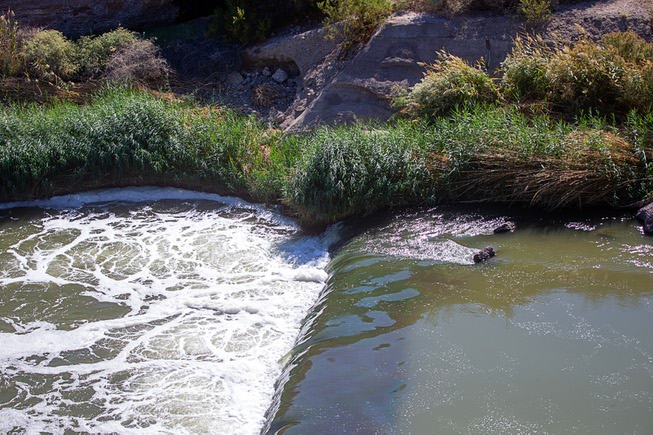
Water flows over a water control structure in the Las Vegas Wash, east of Lake Las Vegas, in the Lake Mead National Recreation Area Tuesday, Oct. 24, 2023.
Friday, Nov. 3, 2023 | 2 a.m.
The Southern Nevada Water Authority plans to build $61 million of aquatic “speed bumps” to slow the flow of water down the Las Vegas Wash, the first of five planned projects to help prevent erosion.
When water rushes through the wash too quickly, it eats away at the banks, deepens the channel and dumps sediment into Lake Mead, all of which can have unwanted environmental consequences.
“It’s really about managing the waterway and helping to ensure that we aren’t further seeing erosion occur,” said Bronson Mack, a spokesman for the Water Authority.
The wash is a 12-mile channel through the Las Vegas Valley that collects stormwater and other urban runoff, feeding it into Lake Mead.
The Water Authority installed four low dams, or weirs, in the upper section of the wash between 2002 and 2017.
The latest project, set to begin next year, will add five more weirs along the final 3.5 miles of the wash before it drains into Lake Mead.
Federal and state grants will cover $15 million of the cost, and the Water Authority is seeking additional funding for the balance.
Some of the weirs will be made of loose rocks, called riprap, but the first one will be a concrete structure constructed in a stair-step fashion. It will span 162 feet across the wash, stand 15 feet tall and stretch about 150 feet long.
Over the past 50 years, significant erosion has widened and deepened the wash, and the lake has receded, extending the wash’s length, Mack said.
Preventing further erosion will cut down on sediment washing downstream into Lake Mead. Sedimentation lessens the life of the reservoir.
“As we saw the lake levels receding in Lake Mead, it was pretty evident we needed to add some additional weirs within the lower section of the wash,” Mack said.
Flooding over the past few years has damaged some of the existing structures.
A weir near the Northshore Road bridge over the wash has developed cracks and leaks. Fixing it would help protect the bridge from the effects of erosion, Mack said.
The Water Authority plans to build the new weirs over the next five to 10 years.
Once the new weirs are in place, the wildlife habitats along the shoreline will have more protection from fluctuating water levels, officials said.
Carrie Norman, a biologist who has worked with the National Parks Service for 21 years, said large fluctuations in water levels in the wash can damage the shoreline and take out habitats that have developed over time.
Cottonwood, willow and mesquite trees, along with aquatic plants, grow in and along the wash, creating habitats for migratory birds, foxes, coyotes and ringtails. The plants also help filter out pollutants from upstream.
“That’s what the wildlife really needs to have,” Norman said. “Plants are the backbone of the ecosystem. If you have big floods, it wipes it out every time.”
When rising and falling water levels don’t disrupt their development, the habitats are self-sustaining to a degree. Seeds and branches from the upstream Wetlands Park and the Henderson Bird Preserve fall into the stream and spread vegetation throughout the wash.
Lower water levels mean more tree growth over time, but habitats can be lost when the water rises or recedes too much.
The National Parks Service tries to replace some of the lost plant life and restore the lost habitat, but it can be tricky, Norman said.
“It’s difficult to do revegetation in an area if you don’t know if the water is going to come up 10 feet,” Norman said.
If not for the weirs near the Northshore Road bridge, the hillside would have continued to erode and degrade at a faster pace, she said.
[email protected] / 702-948-7836 / @Missmusetta
